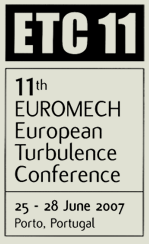Speakers
LES of compressible inert and reacting shear flows
Rainer Friedrich
FG Strömungsmechanik
Technische Universität München
D-85748 Garching, Germany
The transport of mass, momentum and energy in inert and reacting compressible turbulent flows is governed by a considerable number of nonlinear terms in the basic equations. This number increases with the number of species that mix and with the diffusion mechanisms involved (cross diffusion, thermo-diffusion). Depending on the form of the equations and the choice of the flow variables, there exist various forms of these nonlinearities. Classical subgrid-scale modelling that treats each closure problem resulting from convection and diffusion processes individually has to adjust to the specific form of the basic equations. An advantage of LES techniques like the Approximate Deconvolution Method (ADM) and related methods becomes evident at this point, namely their ease of implementation and independence of shape and number of such unclosed terms. Modelling issues resulting from chemical source terms are much more complex and need special consideration.
The paper reports on LES of compressible flow through pipes and channels and on LES of temporal inert and reacting mixing layers. The basic equations are the Navier-Stokes and species transport equations. In DNS which serves to test the LES approach these equations are discretized in space using 6th order central compact schemes and a third-order optimized Runge-Kutta scheme for time advancement. Our LES approach (Mathew et al., Phys. Fluids 2003, pp. 2279) is an interpretation of the ADM method of Stolz and Adams (1999) as a nearly equivalent procedure of explicit, low-pass filtering of the solution between integration time-steps using a composite filter. Like ADM, the success of which is to a great deal due to the use of high-resolution compact schemes, the present method successfully predicts turbulent transport processes in supersonic pipe and channel flows and large-scale mixing of active scalars in temporal inert and reacting shear layers.
The presented LES approach is reliable enough to investigate structural changes in the Reynolds stress and pressure-strain correlation tensors due to compressibility and heat release and to provide explanations for their appearance.
| © 2006 ETC11 | http://etc11.fe.up.pt | etc11@fe.up.pt |
